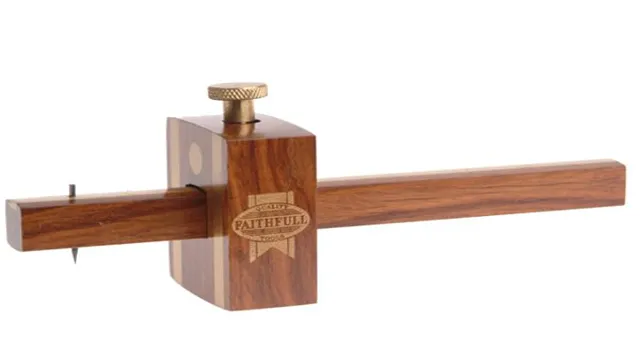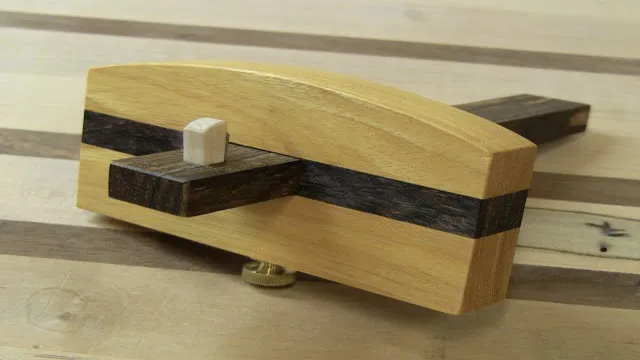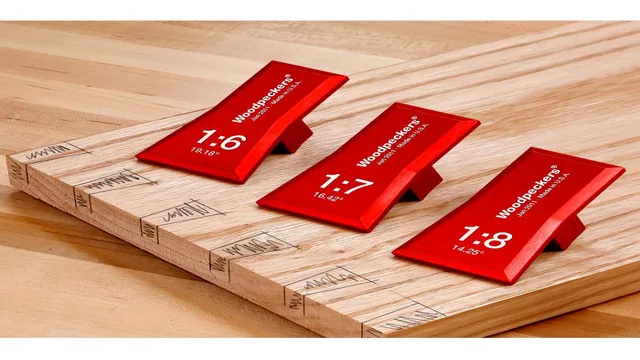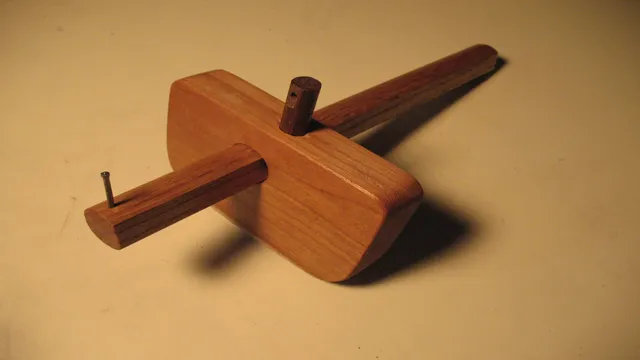How to Make a Center Marking Gauge: Step-by-Step Guide for Precision Woodworking
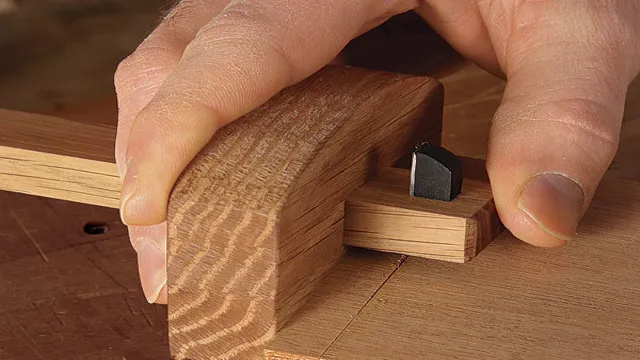
Have you ever struggled with finding the exact center point on a piece of wood or metal? It can be a frustrating task, but with a center marking gauge, you can take the guesswork out of it. This simple tool is easy to make and can make a big difference in the precision of your projects. In this guide, we’ll walk you through the steps to make your own center marking gauge, so you can achieve accurate results every time.
Let’s get started!
Introduction
If you’re looking for a tool to help you make precise markings on your woodworking projects, a center marking gauge is an essential addition to your toolbox. The good news is that you don’t have to spend a lot of money to buy one. With some basic woodworking skills and tools, you can easily make your own center marking gauge.
To start, you’ll need a piece of hardwood, a metal rod, a drill press, and a handsaw. Simply drill a hole in the center of the hardwood for the metal rod to fit snugly into, and saw off the excess wood to create a handle. Then, mark a line on the rod that indicates the center point and attach it to the handle.
Voila! Your homemade center marking gauge is ready to use. With a little practice, you’ll be able to make accurate markings on your projects every time.
Explanation of Center Marking Gauge
Center marking gauges are frequently used by woodworkers to create accurate markings for center points on wood. These gauges are essential for tasks like drilling holes in the center of a piece of wood or aligning objects precisely. They work by drawing two perpendicular lines that intersect at the center of the piece of wood, marking the spot where the hole should be drilled.
The gauge typically consists of a body, a fence, and a marking point. The body is used to hold the gauge, and the fence is used to guide it along the edge of the wood. Meanwhile, the marking point is adjustable and can be moved up or down to make accurate measurements.
Overall, center marking gauges are critical tools for anyone looking for precise measurements in woodworking.
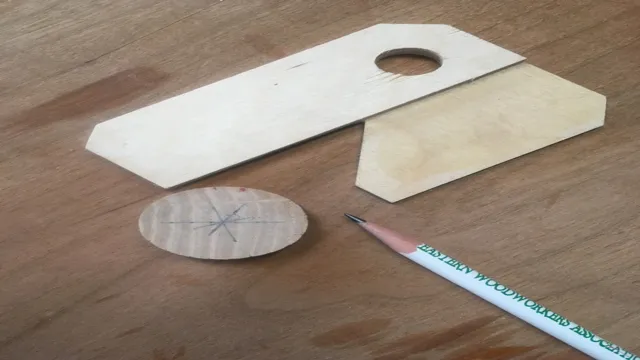
Materials Needed
Making a center marking gauge is a great DIY project that can be done within a short period of time. To start, you will need some basic materials such as a block of hardwood and a metal ruler. Additionally, you will need a drill, a saw, a square, a pencil, and some sandpaper.
If you want to add some creative flair to your marking gauge, you can use other finishing materials like lacquer and wax. The block of hardwood is the base of your marking gauge, and it should be about 6 inches long and 1 inch thick. You can choose any type of hardwood that you like, but make sure it’s durable enough for daily use.
You can also use recycled wood to make the project more eco-friendly. The metal ruler should be longer than the block of hardwood, and you can buy it at any hardware store. By gathering these materials, you are ready to create a center marking gauge that is both functional and aesthetically pleasing.
List of Materials
If you’re planning a DIY project, knowing the materials you’ll need ahead of time can save you trips to the store and stress. The specific materials you’ll need will vary depending on the project, of course, but there are a few general categories you should consider. First, you’ll need tools like hammers, drills, and saws, as well as safety gear like goggles and gloves.
You’ll also need materials like screws, nails, and adhesives to fasten everything together. Depending on what you’re making, you may need lumber, plywood, or other building materials. If you’re doing something like painting or staining, you’ll need brushes, rollers, and your chosen finish.
Finally, if you’re working with electricity or plumbing, you may need specific components like wires or pipes. Take some time to plan out your project and make a comprehensive list of materials before you get started. Trust us, it will save you a lot of headaches down the road.
Step-by-Step Instructions
If you’re looking to make a center marking gauge, it’s not as difficult as you may think. First, gather the necessary materials, which include a hardwood stock, a cutter, brass thumb screws, and a marking spur. The stock should be about 6 inches in length, 3/4 inch thick, and 3 inches wide.
Then, mark the center of the stock and use a hand saw to cut a groove down the center of the stock. Next, insert the marking spur and secure it in place with brass thumb screws. Finally, sharpen the cutter and screw it onto the end of the stock opposite the marking spur.
Congratulations, you now have a homemade center marking gauge! This trusty tool will come in handy for any woodworking projects where you need to mark a precise center point.
Step 1: Cutting the Pieces
When it comes to making your very own wooden puzzle, the first step is cutting the pieces. This can seem quite daunting if you’ve never tried it before, but it’s actually not as difficult as you might think. The key is to take your time and work carefully, ensuring that each piece is cut accurately and to the correct shape.
To begin, you’ll need a piece of wood to use as your puzzle base, as well as a saw and a set of puzzle templates or patterns. Start by transferring the templates or patterns onto your wood, using a pencil to trace around each shape. Then, using your saw, carefully cut out each piece, following the traced lines and taking care to keep your cuts straight and smooth.
With patience and practice, you’ll soon find that cutting puzzle pieces becomes second nature, and you’ll be well on your way towards creating your very own custom-made puzzle masterpiece!
Step 2: Drilling Holes
After gathering all your necessary tools, the second step in drilling holes is getting to work. Using a marker or pen, mark where you want the holes to be. Double-check your measurements before drilling, to ensure accuracy.
Next, select the correct drill bit size, appropriate for the size of the hole you want. Now, place the drill bit at the marked point and apply light pressure to the drill. Keep a steady hand and maintain a straight angle, drilling slowly and steadily.
Changing the angle of the drill will result in an uneven hole or a crooked angle. Make sure to wear protective gear like gloves and goggles to protect your hands and eyes from debris while drilling. For the best results, it’s recommended that you work on a stable surface with a firm grip on the drill.
With patience and focus, you’ll have the perfect hole in no time!
Step 3: Cutting the Bevels
Now that you have your wood pieces cut to size and clamped together, it’s time to move on to the next step: cutting the bevels. First, mark where you want the bevels to go using a pencil. Then, using a miter saw or circular saw, carefully make angled cuts along the marked lines.
This will create the beveled edges that give your piece a more refined and polished look. Be sure to take your time with this step, as precise cuts are important for achieving a professional result. Remember, measure twice and cut once! With some practice, you’ll soon be a pro at creating perfectly cut bevels on your woodworking projects.
Step 4: Assembling the Gauge
After gathering all the necessary materials, it’s time to assemble the tire pressure gauge. Begin by attaching the hose to the gauge’s air valve. Make sure the connection is secure by tightening it with your fingers.
Then, connect the other end of the hose to the tire’s valve stem, ensuring that it is also tightly secured. Press the gauge firmly onto the valve stem, making sure that it is seated properly and there are no leaks. Finally, read the gauge’s display and compare it to the recommended tire pressure for your vehicle.
If the pressure is too high or too low, adjust it accordingly. With these simple steps, you can assemble the gauge and accurately measure your tire pressure to ensure a safe and smooth ride. So, what are you waiting for? Grab your materials and get started!
Using the Center Marking Gauge
If you’re looking to make precise center markings on your woodworking projects, a center marking gauge is a must-have tool. Luckily, you don’t have to spend a lot of money to acquire one – you can easily make your own! To do so, all you’ll need is a small block of wood, a nail or small screw, and a few basic woodworking tools. Start by drilling a hole in the center of your block of wood and driving your nail or screw into the hole.
Then, make two marks on opposite sides of the block exactly halfway between the nail/screw and the edge. These are your center markings! To use the gauge, place the nail/screw in the center of your workpiece and line up the two markings with the edges. Then, run your pencil along the opposite edge to create a precise center line.
With a little practice, you’ll be able to make accurate center markings on all of your woodworking projects!
Instructions for Use
Are you struggling with finding the right center point in your woodwork project? Look no further than the Center Marking Gauge! This helpful tool allows for precise measurements and markings to be made, ensuring that your project is properly aligned and balanced. To use the Center Marking Gauge, begin by adjusting the height of the blade to match the thickness of your wood. Then, place the gauge on the edge of your wood and slide the blade so it touches the surface.
Hold the gauge steady and draw a line across the wood with a pencil or knife. This will mark the center point accurately. Use the Center Marking Gauge for all your woodworking needs, from furniture to decorations.
Your projects will never have looked better!
Conclusion
In conclusion, crafting your own center marking gauge is not only a fun and rewarding experience, but it also allows for customization and personalization. Plus, you’ll impress your woodworking colleagues with your new handmade tool! So go ahead, grab some scrap wood and a sharp pencil, and let the creative juices flow. Just remember, measure twice, cut once (or in this case, mark accurately)!
Summary of Steps
The Center Marking Gauge is an essential tool for woodworkers and craftsmen, especially for those who work with circular objects like bowls and plates. Here’s a quick summary of how to use it: First, adjust the blade to the desired width and lock it in place. Then, position the gauge on the centerline of the workpiece, sliding the blade along the surface to make a light mark.
Once you have marked two opposite edges, use a straightedge or ruler to connect the lines and find the centerpoint. And voila, you have a perfect center point for drilling, cutting, or any other operation that requires precision. With a few simple steps, the Center Marking Gauge can help you save time and avoid mistakes in your woodworking projects.
So if you want to take your craftsmanship to the next level, don’t hesitate to add this handy tool to your kit today!
FAQs
What is a center marking gauge used for?
A center marking gauge is a tool used to mark the center of a piece of wood or other material for precision cutting or drilling.
What materials are needed to make a center marking gauge?
Materials needed to make a center marking gauge include a piece of wood or plastic for the body, a hardened steel bar for the marking tip, and hardware such as screws and washers.
Can you make a center marking gauge without power tools?
Yes, a center marking gauge can be made using only hand tools such as a saw, drill, and file.
How do you use a center marking gauge?
To use a center marking gauge, first adjust the marking tip to the desired distance from the body. Then, press the tip onto the surface of the material and slide the body along the edge to create a precise center mark.
How accurate are center marking gauges?
Center marking gauges can be very accurate when made and used correctly. Precision depends on the quality of the materials used and the user’s skill in creating and using the tool.
What are some common mistakes when using a center marking gauge?
Common mistakes when using a center marking gauge include failing to adjust the marking tip to the correct distance, pushing too hard or not hard enough when making the mark, and sliding the body off course while making the mark.
How do you maintain a center marking gauge?
To maintain a center marking gauge, keep it clean and dry when not in use and periodically check and adjust the marking tip for accuracy. Sharpen or replace the marking tip as needed.

